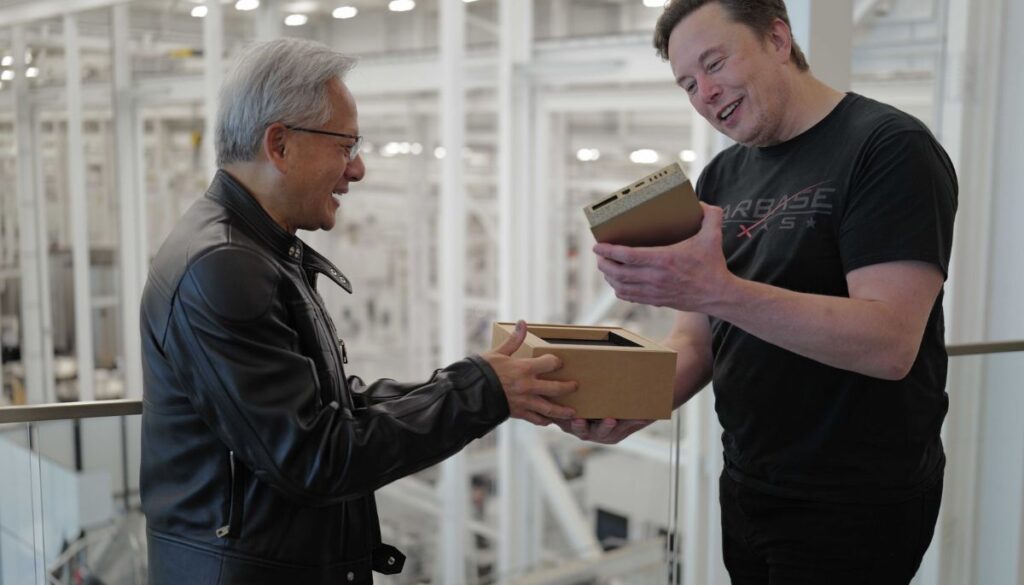In a highly symbolic gesture marking the next phase of the artificial intelligence revolution, NVIDIA founder and CEO Jensen Huang personally delivered the new NVIDIA DGX Spark Spark desktop AI supercomputer to Elon Musk at the SpaceX Starbase facility in Texas. The handoff, set against a dramatic backdrop of towering rocket engines, was immediately recognized by the technology world as a pivotal moment signaling the shift of world-class AI compute power from sprawling, centralized data centers to the hands of individual developers, researchers, and creators.
The NVIDIA DGX Spark is the smallest and most powerful AI supercomputer of its kind, packing the full NVIDIA AI platform including GPUs, CPUs, networking, and software into a compact desktop form factor. The system delivers up to one petaflop of AI performance and 128 GB of unified memory, giving developers the capacity to run inference on models with up to 200 billion parameters and fine-tune models with up to 70 billion parameters locally.
The NVIDIA DGX Spark Legacy of the First Handoff
The delivery at Starbase consciously echoed a legendary moment in the history of AI. In 2016, Jensen Huang personally delivered the first-ever NVIDIA DGX Spark DGX-1 supercomputer to a nascent startup called OpenAI, where Elon Musk was a co-founder.
Recounting that seminal event, Huang emphasized the continuity of the mission: “In 2016, we built DGX-1 to give AI researchers their own supercomputer. I hand-delivered the first system to Elon at a small startup called OpenAI and from it came ChatGPT, kickstarting the AI revolution,” he stated. “With DGX Spark, we return to that mission placing an AI computer in the hands of every developer to ignite the next wave of breakthroughs.
The NVIDIA DGX Spark visual contrast at the Starbase facility the “smallest supercomputer next to the biggest rocket” underscored NVIDIA’s declaration: that the future of agentic and physical AI development lies not just in giant, centralized cloud infrastructure, but in distributed, accessible processing power that allows developers to innovate closer to the application, whether that’s in robotics labs, creative studios, or, indeed, next to a rocket launch pad.
NVIDIA DGX Spark Data Center Power on the Desktop
The NVIDIA DGX Spark represents a tremendous technological leap in desktop computing power, driven by the new NVIDIA Grace Blackwell (GB10) Superchip architecture.
The system’s one petaflop of performance is exponentially more powerful than its 2016 predecessor, the DGX-1, which offered 170 teraflops of performance and was significantly larger and more expensive (costing $129,000). This massive jump is crucial because modern AI workloads, particularly those involving large language models (LLMs) and advanced AI agents, are quickly outgrowing the memory and software capabilities of conventional PCs and workstations, often forcing developers to rely on cloud services.
The NVIDIA DGX Spark addresses this bottleneck directly by integrating a full AI stack including GPUs, CPUs, networking (ConnectX-7), and the entire NVIDIA AI software ecosystem (including CUDA libraries and NVIDIA NIM microservices) into a cohesive, desktop unit. This unique capability allows developers to perform resource-intensive tasks like fine-tuning large models and developing AI agents entirely locally, enhancing both security and control over sensitive data that might otherwise be relegated to the cloud.
NVIDIA DGX Spark Democratizing AI Infrastructure
The move to democratize supercomputing-class AI marks a strategic acceleration of development outside the big tech companies. While centralized data centers are rapidly being constructed to house multi-gigawatt AI clusters, the NVIDIA DGX Spark places the power needed for advanced research and prototyping directly onto the desks of millions of developers.
- Reduced Capital Expense: It optimizes operational costs by reducing the initial capital investment required for dedicated data center hardware access.
- Faster Iteration: By running complex models locally, developers accelerate the time required for data preparation and experimentation, improving iteration speed.
- Enhanced Security: It allows organizations in regulated industries to keep their sensitive data and AI models in-house, ensuring crucial regulatory compliance and control.
NVIDIA DGX Spark Market Impact and Commercial Availability
The launch of the NVIDIA DGX Spark is supported by a robust ecosystem of global Original Equipment Manufacturers (OEMs), including Dell Technologies, ASUS, Acer, HP, GIGABYTE, Lenovo, and MSI, who are debuting the new DGX Spark systems. The DGX Spark is set to ship worldwide starting October 15, and the initial recipients include a who’s who of cutting-edge technology companies and institutions, such as Anaconda, Cadence, Google, and the Arizona State Robotics Lab.
This wide availability and rapid adoption indicate that the market is embracing Huang’s vision of distributed AI computing. The accessibility of petaflop-scale performance on a desktop is expected to drive significant breakthroughs in agentic AI development systems designed to reason, plan, and act autonomously and physical AI, particularly in robotics and autonomous systems.
The NVIDIA DGX Spark effectively positions NVIDIA’s full-stack AI platform to power the future of enterprise AI, extending its reach from massive cloud platforms and DGX SuperPODs (used by nine of the top ten U.S. Government institutions and seven of the top ten global pharmaceutical companies) down to the individual developer’s workspace.
Conclusion: The Desktop AI Revolution
The hand-delivery of the NVIDIA DGX Spark by Jensen Huang to Elon Musk is far more than a marketing stunt; it is a powerful declaration that the democratization of AI supercomputing is now a reality. Just as the DGX-1 catalyzed the foundation of modern LLMs, the DGX Spark promises to unlock the next wave of AI breakthroughs by putting immense computational power into the hands of millions.
For developers and enterprises, this new desktop supercomputer translates directly into a reduction in the time-to-solution, accelerating the development of sophisticated AI agents and generative models that were previously restricted to the world’s largest data centers. The DGX Spark marks a defining moment, confirming that the race for AI supremacy will be won not just by the biggest cloud providers, but by the developers who can execute their ideas with the greatest speed, security, and focus.

